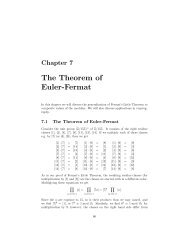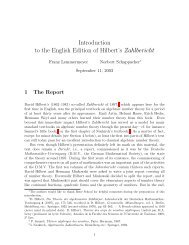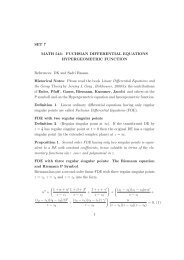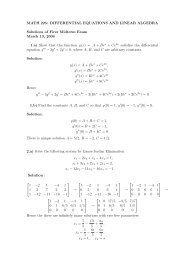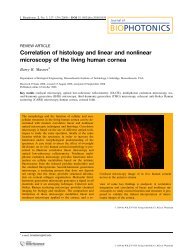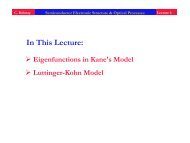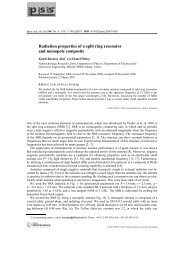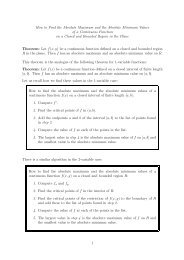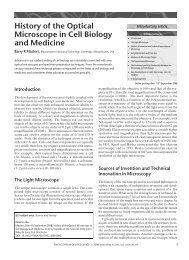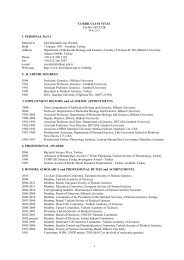Jump processes in surface diffusion - Bilkent University - Faculty of ...
Jump processes in surface diffusion - Bilkent University - Faculty of ...
Jump processes in surface diffusion - Bilkent University - Faculty of ...
You also want an ePaper? Increase the reach of your titles
YUMPU automatically turns print PDFs into web optimized ePapers that Google loves.
42 G. Antczak, G. Ehrlich / Surface Science Reports 62 (2007) 39–61<br />
Fig. 6. Distribution <strong>of</strong> atomic weights <strong>of</strong> <strong>in</strong>dividual atoms field evaporated<br />
from Ir(110) <strong>surface</strong> [6]. Top: after deposition <strong>of</strong> Ir atom. Bottom: after<br />
deposition <strong>of</strong> W atom. Center: After deposition <strong>of</strong> W atom, followed by heat<strong>in</strong>g<br />
and observed cross-channel <strong>diffusion</strong> event; material desorbed is iridium.<br />
Fig. 7. Atomic weight distribution <strong>of</strong> material field evaporated from first<br />
Ir(110) layer [6]. Left: after cross-channel <strong>diffusion</strong> has occurred, a W atom<br />
is detected <strong>in</strong> the first substrate layer. Right: when no cross-channel motion was<br />
detected, iridium is desorbed.<br />
cross-channel motion was discovered, the latter with a<br />
lower activation energy. In cross-channel <strong>diffusion</strong> they aga<strong>in</strong><br />
envisioned a dumbbell <strong>in</strong>termediate, as shown <strong>in</strong> Fig. 8(b),<br />
<strong>in</strong> which a pair <strong>of</strong> atoms sat across the ridgel<strong>in</strong>e. When<br />
this decomposes, the adatom can move back to its orig<strong>in</strong>al<br />
channel, or else it can move <strong>in</strong>to the channel wall, plac<strong>in</strong>g<br />
a lattice atom <strong>in</strong> the adjacent channel. Additional simulations<br />
<strong>of</strong> <strong>diffusion</strong> across channels on a Lennard-Jones fcc crystal<br />
were done by Mruzik and Pound [12]. On the (110) plane,<br />
cross-channel motion aga<strong>in</strong> occurred by exchange with a lattice<br />
atom, but movement on the (113) plane was along the channels.<br />
Gar<strong>of</strong>al<strong>in</strong>i and Halicioglu [13] did similar estimates on the<br />
Pt(110) plane at both low and high temperatures. At lower<br />
temperatures both iridium and gold atoms diffused along the<br />
channels, but at higher temperatures exchange took place for<br />
iridium, and a plat<strong>in</strong>um lattice atom appeared <strong>in</strong> the next<br />
channel. Gold at this temperature also formed a dumbbell<br />
with an atom from the channel wall, but returned to cont<strong>in</strong>ue<br />
<strong>diffusion</strong> <strong>in</strong> its orig<strong>in</strong>al channel, so <strong>diffusion</strong> was really onedimensional.<br />
More experimental work was reported <strong>in</strong> 1982 by<br />
Wrigley [14], who exam<strong>in</strong>ed the temperature dependence <strong>of</strong><br />
cross-channel motion, as shown <strong>in</strong> Fig. 10, with an activation<br />
energy <strong>of</strong> 0.74 ± 0.09 eV and a prefactor 1.4(×16 ±1 ) ×<br />
10 −6 cm 2 /s. Data were obta<strong>in</strong>ed at only five temperatures,<br />
and keep<strong>in</strong>g <strong>in</strong> m<strong>in</strong>d the low prefactor, must be viewed with<br />
some doubt. What was not clear at this po<strong>in</strong>t was the reason<br />
for the magnitude <strong>of</strong> the prefactor. Was it associated with the<br />
complicated mechanism, or were the measurements not detailed<br />
enough?<br />
At essentially the same time, Tung and Graham [15] looked<br />
at self-<strong>diffusion</strong> on various <strong>surface</strong>s <strong>of</strong> nickel. The behaviour<br />
<strong>of</strong> the (110) plane varied depend<strong>in</strong>g on whether it had been<br />
cleaned thermally, or had been subjected to field evaporation<br />
<strong>in</strong> hydrogen gas. Diffusion measurements were made after the<br />
hydrogen treatment and some field evaporation, as well as after<br />
thermal clean<strong>in</strong>g only, and gave the results shown <strong>in</strong> Fig. 11. For<br />
both treatments self-<strong>diffusion</strong> was two-dimensional on Ni(110);<br />
however, <strong>diffusion</strong> after thermal treatment led to very low<br />
<strong>diffusion</strong> prefactors ∼10 −7 –10 −9 cm 2 /s, with an activation<br />
energy <strong>of</strong> 0.23 ± 0.04 eV for <strong>in</strong>-channel movement and 0.32 ±<br />
0.05 eV across the channels. After hydrogen treatment, the<br />
characteristics for <strong>in</strong>-channel motion were a <strong>diffusion</strong> barrier<br />
<strong>of</strong> 0.30 ± 0.06 eV and a prefactor <strong>of</strong> 10 1 cm 2 /s; for crosschannel<br />
<strong>diffusion</strong> the barrier was lower, 0.25 ± 0.06 eV, with<br />
a prefactor <strong>of</strong> 10 −1 cm 2 /s. In the temperature range 80–90<br />
K, cross-channel motion predom<strong>in</strong>ated. On Ni(331) and (113),<br />
however, movement was always one-dimensional. Tung [16]<br />
also briefly studied self-<strong>diffusion</strong> on Al(110), determ<strong>in</strong><strong>in</strong>g<br />
the temperature for the beg<strong>in</strong>n<strong>in</strong>g <strong>of</strong> atom movement. Twodimensional<br />
<strong>diffusion</strong> was observed on the (110) plane, at a<br />
temperature <strong>of</strong> 154 K for both directions, lead<strong>in</strong>g to an estimate<br />
<strong>of</strong> 0.43 eV for the activation energy. It should be noted that<br />
the <strong>diffusion</strong> characteristics, both for nickel and alum<strong>in</strong>um<br />
(110) are uncerta<strong>in</strong>, and the data have been reanalyzed [17].<br />
Nevertheless, these observations firmly established crosschannel<br />
motion on these <strong>surface</strong>s.<br />
Another five years later, <strong>in</strong> 1986, Kellogg [18] measured<br />
the rates <strong>of</strong> <strong>in</strong>- and cross-channel self-<strong>diffusion</strong> on Pt(110)<br />
over a range <strong>of</strong> temperatures. From an Arrhenius plot, shown<br />
<strong>in</strong> Fig. 12, he found an activation <strong>of</strong> 0.72 ± 0.07 eV with a<br />
prefactor <strong>of</strong> 6 × 10 −4 cm 2 /s for <strong>diffusion</strong> along the channels,



